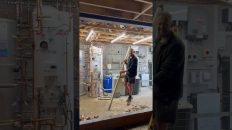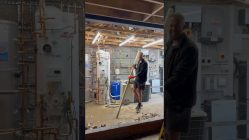#ACS #Gas Understanding Controls / ACS Gas Training
NGCFE | ACS Gas Training Controls.
Gas controls / FSD’s / Thermostats
Thermocouple
A thermocouple is a device made of two metals, that when heated, will create a small current. This current is sufficient enough to energize the magnet withing a thermos electric valve so that the valve remains open so long as the thermocouple is being heated. When the flame is extinguished, the thermocouple stops creating the current and, as a result, the thermoelectric valve shuts.
Thermostat
A thermostat is a device that is used to measure and (in most cases) maintain a temperature within a space / unit. There are various different types however the main types consist of liquid expansion, bi-metallic, rod type and electric thermostats.
FSD (flame supervision device)
Flame supervision devices come in a variety of different methods. Some of the more notable FSD’s are thermoelectric, liquid expansion and flame rectification. The main function of FSD’s is to monitor the presence of a flame. Should the flame extinguish then the FSD will cut off the gas supply and prevent unburnt gas from escaping.
Liquid expansion valves
Liquid expansion valves can be used either as thermostats or as FSD’s. They utilise a phial and capillary tube that contains a vapour. When the phial is heated, the vapour will expand and either open or close a set of bellows or a microswitch. This will in turn either open or close the gas supply to a burner.
Thermoelectric valves
Thermoelectric valves always work in conjunction with a thermocouple. The user manually opens the spring-loaded valve until the thermocouple creates a current that will energize the magnet within the thermoelectric valve. The valve will remain open until the thermocouple loses its charge at which point the valve will spring shut.
SSOV (safety shut off valve)
This device is usually associated with cookers. The cooker lid has a mechanical lever or a form of plunger that when closed, will close off the gas supply to the hotplate.
Interruptible thermoelectric valve
Some thermoelectric valves have interrupters wired into them in series. The reason for this is so that a circuit breaker can be introduces into the circuit. This circuit breaker is normally a safety device of some form (usually an overheat thermostat). If the interrupter circuit is broken (e.g., The overheat thermostat has operated) then the thermoelectric valve will close as it will lose its charge.
Solenoid valve
A solenoid valve has a coil inside that will act as a magnet when electricity is passed through it. This magnet will draw the valve open until such a time as the coil loses its charge and the spring-loaded valve closes.
Low pressure regulator
A low-pressure regulator is used to maintain a constant outlet pressure. The regulator does this by utilising a spring loaded diaphragm and plunger that will maintain the outlet pressure when the demand increases or decreases at the outlet of the regulator.
Multifunctional control valve
The multifunctional control valve incorporates three main components. It has a thermoelectric valve that is used as an FSD to the pilot light, a regulator that can be used to range rate the outlet pressure of the appliance and a solenoid valve that works in conjunction with an electric thermostat to open or close the gas supply to the main burner.
ODS (oxygen depletion sensor)
The ODS works in the same way and an atmospheric sensing device (ASD). It takes the combustion air for the pilot light from above the heat exchanger. Should the appliance burn incorrectly, the vitiated poor air (containing CO) above the heat exchanger will be drawn into the ODS and the pilot light will become vitiates. The thermocouple will then cool resulting in the valve closing the gas supply.
Zero-governor / air-gas ratio valve
The zero governor works in conjunction with a fan. The fan sucks the gas through the valve and mixes it with air before delivering it to a burner at a pre-determined ratio.
Flame rectification
Flame rectification is present on the vast majority of boiler and water heaters in the modern day. The circuit board on the appliance sends a current to the rectification probe. When the burner lights, the current present at the rectification probe travels through the flame, converting from AC current to DC current in the process. It then travels back to the circuit board via an earth or ground wire. When the board senses DC current, it knows that there is a flame present and stops trying to ignite the gas supply at the burner. Should the flame be extinguished for any reason, the board will stop receiving DC current and will cut out the gas supply to the burner.
Best regards
Michael Hunt
Managing Director
National Gas Centre for Excellence







